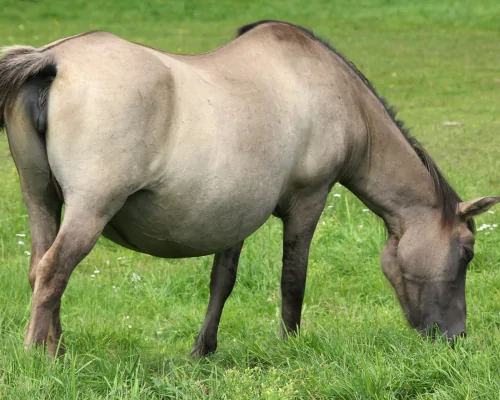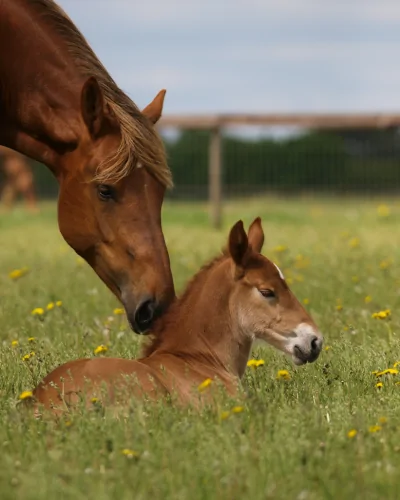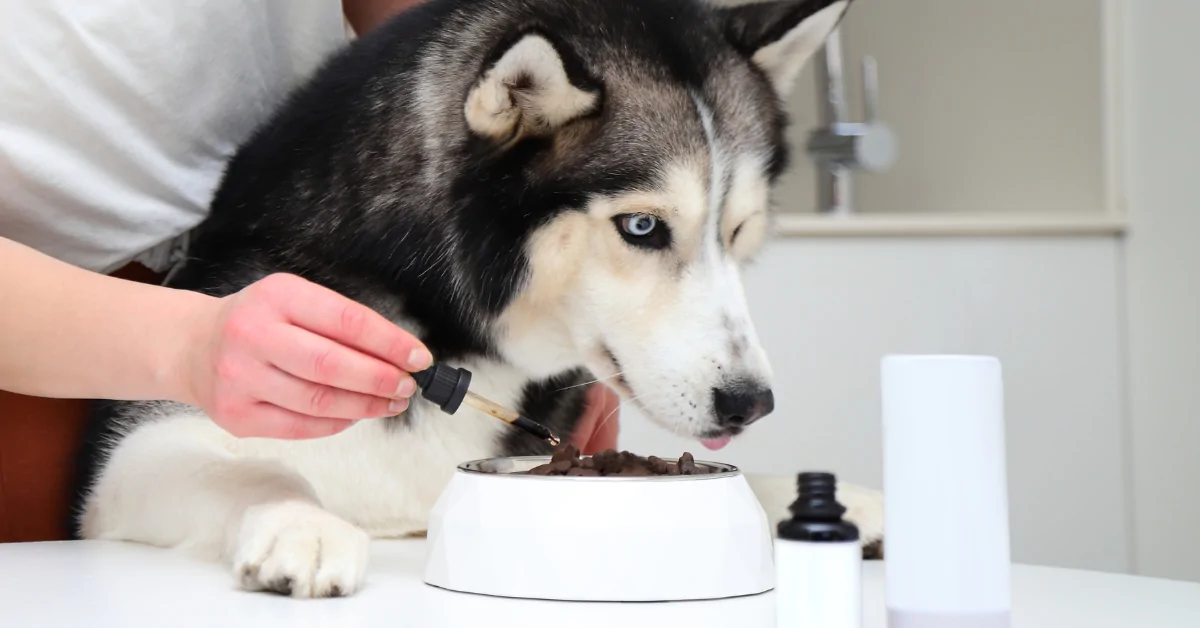Quick. How old is your dog?
No, not in human years. In dog years. You probably thought— well, compute whatever their human-years age is and multiply by seven.
And we totally understand where the instinct to use that formula comes from. Unfortunately, recent scientific research reveals that this handy rule-of-thumb is more pop wisdom than actual science.
In reality, calculating your dog’s true age in dog years requires some pretty intense math. But the reward is being able to know how far along in their life your four-legged friend really is.
In this article, we break down where the myth of comparing seven dog years to every human year comes from. We’ll show how to accurately measure a dog’s age, and how to tell your dog is getting older.
Where Does the 7:1 Ratio About Age in Dog Years Come From?

It wasn’t until the 20th century that a rhetoric emerged about dog years even being a subject of interest. In the 1950s, it became a rule-of-thumb that most humans lived to 70 while most dogs lived to about ten years old. As a result, a shorthand ratio of 7:1 entered pet owners’ lexicons. This ratio was then enshrined in popular media through a variety of mediums The most notable is via a series of Alpo commercials in the 1970s that ran the tagline: “Duchess is 13. That’s like 91 to you and me.”
Ratio Under Question
However, almost as soon as it entered the collective brain, this ratio came under intense scrutiny from veterinarians, animal researchers, and gerontologists. In 1953, French researcher A. Lebeau categorized life-stage markers that humans and dogs share in common. Those being puberty, adulthood, and maximum lifespan. His work also uncovered the remarkable fact that, in a dog’s first year of life, a dog will age between 15 to 20 times faster than a human. Meanwhile, this ratio shrinks considerably thereafter to a ratio of about five to one (human to dog years).
So, that still leaves the question: if science has exposed this common saying as nothing more than popular mythology, why is still so persistent?
Well, according to Assistant Professor of Veterinary Medicine at Kansas State University William Fortney, it’s likely because of advertisers. “My guess is it was a marketing ploy,” says Fortney, “a way to educate the public on how fast a dog ages compared to a human, predominantly from a health standpoint. It was a way to encourage owners to bring in their pets at least once a year.”
How Should We Measure Age in Dog Years?

As stated by aging expert David J. Waters, “Eight years in one breed is not equivalent to eight years in another.” And we know this already. It’s common knowledge at this point that small dogs tend to live longer than big dogs, meaning that a Dachshund who is one human year old is likely younger in dog years than a one year old Great Dane.
So, if we’re trying to get an accurate understanding of our dog’s age that can account for the variable of their breed, we should try and utilize calculation methods that take these differences into their methodology. One such method like this was crafted by researchers at the University of California – San Diego School of Medicine.
Aging by DNA
After comparing changes in DNA over time between groups of humans and Labrador Retrievers, the researchers concluded that the most accurate method of translating a dog’s age into human years was to multiply the natural logarithm of the dog’s age by 16 and adding 31 to that figure. The formula looks like this: (human_age = 16ln(dog_age)+31).
“[This research] validates what a lot of other researchers have been saying,” said Casal, a professor of medical genetics, pediatrics and reproduction at the University of Pennsylvania School of Veterinary Medicine.
Luckily, you don’t need to pull out your old graphing calculator from high school calculus. There are plenty of handy online calculators that utilize this formula already and are much more intuitive to use. What even is a natural log anyway? Aren’t all logs natural?
Of course, if computation isn’t really what you came to a pet blog to do (I mean, who can blame you?), then there is an even simpler formula you can use. Just remember that the first year of a dog’s life is equal to roughly 15 human years. Then, their second year of life is equal to about nine human years. Every year after is equal to about four or five human years.
Why Do Small Dogs Age Slower than Big Dogs?

According to evolutionary biologist and Professor of Biosciences at the University of Melbourne Mark Elgar, “Large dogs die young mainly because they age quickly.” Professor Elgar’s theory is backed by research, particularly a study of 74 dog breeds in North America which concluded that the driving force behind the trade-off between size and lifespan was a strong positive relationship between size and the rate at which the dog ages.
But why? Why do big dogs actually age faster than their micro counterparts?
Hormone Factor
Well, according to evolutionary biologist and researcher Cornelia Kraus at the University of Gottingen in Germany, it may have something to do with their hormonal system. Kraus and her team analyzed demographic data, including age and cause of death, for more than 50,000 dogs across 74 breeds.
What they found was that small dogs have lower concentrations of the growth hormone IGF-1, which has been linked to higher likelihood of death from age-related diseases in organisms with high concentrations of it in their blood. However, this finding alone isn’t enough to cement this theory as fact.
Cynthia Kenyon, a researcher on aging at the University of California at San Francisco, suggests that one way to test the hypothesis that greater concentrations of IGF-1 cause large breeds to die younger would be to take a small dog and give it high levels of IGF-1 while it’s young so that it grows to be large. Then, while it’s an adult, try to extract the excess IGF-1 and see if it has a long life.
Cellular Growth

Whatever the reason is, it’s important that you as a pet owner be able to identify signs of aging in your pup. Just as it’s important to be able to identify nasty skin infections, ringworm, mange, hot spots, or other uncomfortable maladies that may be making your pooch feel ruff. Luckily, if you spot any of the above, you have access to one of the most powerful, clinically-proven antidotes to common ailments: Banixx Pet care!
If you notice your furry friend suffering from any of the above afflictions, just identify the affected area, apply Banixx twice daily, and wait. Soon after application, your dog should feel significant or total relief from whatever fungal or bacterial infection they’re suffering from without needing to rely on pesky antibiotics or steroids. With Banixx, relief is simple.
What Are the Signs of Aging in Dogs?
Everybody ages, including your four-legged friend. The adorable puppy you snuggled has now become a fully-grown dog, and they may have even begun to show it. Their muzzle grays. The gait becomes a bit more stilted. Endless walks have been replaced by short jaunts. Eventually, the evidence may become undeniable: they’re a senior dog.
Of course, some signs are a bit more subtle and, to the untrained eye, may not be identified as signs of aging. For example, some senior dogs’ eyes may become cloudy or milky looking. While this symptom of old age is relatively common and often doesn’t affect their vision, it’s still important to take note of as this may be a sign of cataracts.
 Dog Breath
Dog Breath
You may have heard of puppy breath, but wait till you smell elderly dog breath. More common in dogs who have poor dental health, sudden awful-smelling breath can be a sign of any number of oral maladies including gum disease, tooth decay, or oral infections. As dogs age, their immune system weakens and thus makes them more susceptible to infections. If your dog suddenly presents with truly rancid-smelling breath, it may be time to take them for a dental cleaning and dental exam.
Appearance of Lumps and Bumps
Additionally, you may notice that your dog’s body becomes dotted with new lumps and bumps. Thankfully, many of these randomly-appearing bumps are likely to be benign, fatty tumors known as lipomas. However, it’s never a bad idea to get a second opinion on any newly-sprouted lumps. Remember: many cancers can be effectively treated if caught early enough.
State of Mind
Finally, there’s also the changes that may come to your dog’s mental faculties that you should watch out for. According to a study at the National Center for Biotechnology Information, between 14% and 35% of dogs over eight years old suffer from a type of dementia known as canine cognitive dysfunction syndrome. Changes that may occur as a result of canine cognitive dysfunction syndrome include fear of familiar people, increased barking, house soiling, or a marked change in activity levels.
If your dog is eight years old or older and presenting any of the above symptoms, consider getting them evaluated for canine cognitive dysfunction syndrome. While there is no cure for this disease, your veterinarian may be able to provide you with therapeutic options and medications that can help your dog.
Of course, maybe your dog isn’t even near eight. Maybe they’re just now entering their early twenties (in dog years) and old age is a long time away.
Regardless of whether they’re twenty or 120 in dog years, one thing’s for sure: they’ll always be your fur baby.
Of course, we already know that you care a lot about your dog’s health – otherwise you wouldn’t be reading this blog! That’s why we hope you’ll come back to our blog to learn more about how to keep your furry, four-legged friend happy and healthy. If, on the other hand, you are interested in how to Clean up messy eye boogers or goop or maintain your dog’s nails/claws, yes, we cover that too. Or are you interested in more quirky items? such as how long can a dog go without peeing, yep, we’ve got that covered.
Keep trotting back to us for tips to you keep your dog’s tail wagging with wellness and for any skin calamity or infection reach for your bottle of Banixx Pet Care. You don’t have one? click here to find out where to buy Yours. It’s the most trusted, canine-friendly antiseptic solution on the market.
Sources
-
https://www.icons.org.uk/
theicons/collection/ westminster-abbey/features/ the-great-pavement
-
https://www.youtube.com/watch?
v=B43Lnqs-eUg -
https://online.wsj.com/
articles/SB121997338176882143 -
https://health.ucsd.edu/news/
releases/Pages/2020-07-02-how- old-is-your-dog-in-human- years.aspx -
https://www.pedigree.com/dog-
care/dog-age-calculator - https://www.jstor.org/stable/10.1086/669665
- https://www.insidescience.org/
content/large-dogs-age-faster- die-younger/953 -
https://www.akc.org/expert-
advice/health/physical-mental- signs-dog-aging/
Share this Post
Featured Post
Recent Posts
Lipomas….mysterious Lumps & Bumps on your pup…When should I worry? What should I do about them?

Managing the Mamas –Part 2 –The development process

Managing the Mamas: Part 1 – Preparing to Breed Your Mare

HOW MANY TOES?? Caring for the Polydactyl Cat

Do Dog Joint Supplements Actually Work?


 Dog Breath
Dog Breath